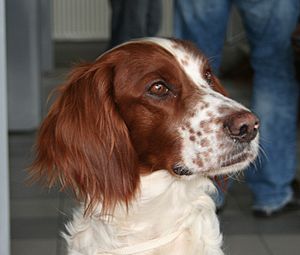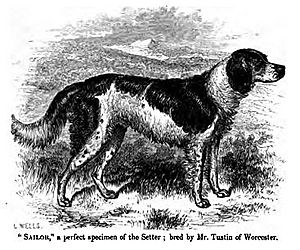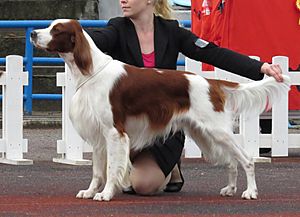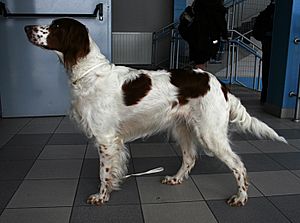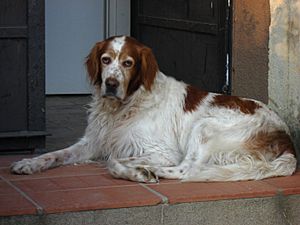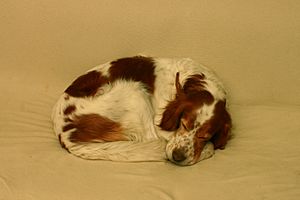Irish Red and White Setter facts for kids
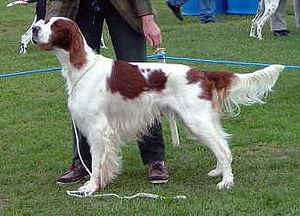 |
|||||||||||||||||||||||
| Common nicknames | Irish R&W Setter IRWS |
||||||||||||||||||||||
|---|---|---|---|---|---|---|---|---|---|---|---|---|---|---|---|---|---|---|---|---|---|---|---|
| Origin | Ireland | ||||||||||||||||||||||
|
|||||||||||||||||||||||
| Domestic dog (Canis lupus familiaris) | |||||||||||||||||||||||
The Irish Red and White Setter (Irish: An Sotar Rua agus Bán) is a special type of dog. Like all setters, it's known as a gundog in places like the UK. In America and Canada, it's part of the sporting dog group. These dogs are very similar to the Irish Setter, Gordon Setter, and English Setter in how they act and what they're used for. However, the Irish Red and White Setter is often seen more as a working dog for hunting.
The main job of this breed was to hunt gamebirds. These are birds like partridge, grouse, pheasant, ptarmigan, snipe, or woodcock. These birds usually hide instead of flying away when a predator is near. In other countries, these setters might hunt quail, willow grouse, or guinea fowl.
Even though this breed has a long history, it almost disappeared by the late 1800s. But in the 1920s, some dedicated dog lovers worked hard to bring the Irish Red and White Setter back. They succeeded in making it a strong breed again. It's still considered a breed that needs protection, but it's now recognized by most major dog clubs around the world.
Contents
What Do Irish Red and White Setters Do?
Setters are amazing at finding and locating game birds. They do this by sniffing the air for the birds' scent. They move quickly and cover a lot of ground, always with their heads held high, looking for clues. Once they find the birds, they "set." This means they freeze in place, showing their handler exactly where the birds are hiding.
When a setter "sets," it might crouch a little, but its body stays tense and still. Its head remains up, taking in the scent, and its eyes stare intensely at where the birds are. Its tail will be held straight out, level with its back. Setters literally point out the birds for hunters.
Dog clubs classify this breed in different groups. In the UK, it's in the Gundog Group. In America and Canada, it's in the Sporting Group. The Fédération Cynologique Internationale (FCI), a big international dog organization, puts them in Group 7, which is for pointing dogs.
The Irish Red and White Setter naturally knows how to work. If they are trained well and given the chance, they are excellent at their original job. They might take a bit longer to train than some other gundogs. But once they learn, they become very loyal and dependable friends. They need training that is firm and clear, but never harsh.
The History of the Irish Red and White Setter
How Did Setters Originate?
'Setting dogges' is an old name for setters. These dogs were first developed to show where game birds were hiding. People used them even in Roman times! The dog would sniff the air to find the birds, then freeze in a standing or crouching position. On command, it would slowly move forward to make the birds fly up.
Long ago, hunters would follow the dog and then release hawks to catch the birds in the air. Later, people started using nets instead of hawks. The setting dogs still showed where the birds were, and the hunter would throw a net over them. By the mid-1600s, guns became more common. Hunting game birds with guns became a popular hobby for wealthy landowners. Setters still found and pointed to birds, but they also had to learn to stay calm when a gun was fired.
By the 17th century, 'setting dogges' were well-known. The different types of setters we see today started to become clear. At first, breeders would mix dogs of different colors. But over time, people started to breed dogs that were best suited for the land they would hunt on.
In Ireland, setters were originally mostly red, or red and white, or even mostly white. All these colors were called Irish Setters, and they were bred together.
Even in 1875, at a dog show in Dublin, many Irish Setters were red and white. Out of 66 entries, 23 were red and white. The next year in Cork, 36 out of 96 entries were red and white. But around this time, solid red-colored setters became very popular. This led to fewer and fewer red and white setters. The solid red Irish Setter became very popular in America and Ireland, and they sold for high prices. This almost caused the Irish Red and White Setter to disappear completely. Luckily, a few breeders in remote parts of Ireland kept the breed alive.
A small number of breeders worked to save the breed from 1775 until the late 1800s. The Rossmore family in County Monaghan, Ireland, had a line of red and white setters since the mid-1700s. This line continued into the 20th century. The family still has many paintings of these dogs. Sometimes, red and white setters were even called Rossmore Setters. Other important owners from that time included Reverend Mahon, Yelverton O'Keefe, and Miss Lidwell. Their dogs were especially known for their excellent hunting skills.
How the Breed Was Revived
After World War I, an Irish clergyman named Noble Huston tried to bring the breed back. But still, there weren't many of them in Ireland. Around 1970, a new plan began to revive the breed, and their numbers slowly started to grow. In 1976, the Irish Kennel Club asked the Irish Red Setter Club to help with the revival of the Irish Red and White Setter.
Thanks to groups like the Irish Red and White Setter Field & Show Society, formed in 1981, the breed became well-known. It gained recognition both in Ireland and around the world. Irish Red and White Setters now do well in dog shows and field trials, earning champion titles in both.
Many people helped bring the breed back. Reverend Huston kept notes about his puppies in the church register. He didn't have official pedigrees (family trees for dogs), but he wrote many letters to Maureen Cuddy. Her kennel name was 'Knockalla'. In one letter, Rev. Huston wrote that the current Red and Whites were not a new breed, but a "continued breed." Because of Maureen Cuddy's careful records and research, the Irish Kennel Club finally agreed in 1974 that the family trees of the few remaining Irish Red and Whites were correct.
It's believed that most Irish Red and White Setters today come from a puppy named Judith Cunningham of Knockalla. Maureen Cuddy helped this puppy get healthy in 1940.
By the 1980s, Irish Red and White Setters were brought to Great Britain. There, they were developed more as show dogs. Interest in Britain grew after Alan and Ann Gormley from Dublin showed an Irish Red and White at Crufts in 1980. This dog was Harlequin of Knockalla, bred by Cuddy in 1977. Harlequin had done well in shows in Ireland to qualify for Crufts. The Gormleys were more interested in showing their dogs than in hunting with them. Harlequin did show he could work when he was young, but his test results were never officially recorded. Harlequin's father was Glenkeen Sandy, whose grandfather was Sulhamstead Natty D'Or, a working dog bred by Florence Nagle.
The breed was not well known in Britain. The Kennel Club accidentally listed Harlequin's Crufts entry with the Irish Setters. This mistake actually sparked a lot of interest in the breed. It showed people that the breed was not extinct, as many had thought.
The Gormleys bred Irish Red and White Setters under their kennel name 'Meudon'. Their dogs became famous worldwide, being sent to Italy, America, Holland, and Great Britain.
However, in Ireland, the breed has mostly remained a working and field trial dog.
On January 1, 2009, the Irish Red and White Setter was fully recognized by the American Kennel Club (AKC). This meant they could compete in all dog shows and competitions. Before this, the breed was listed on the AKC Foundation Stock Service. This is the first step for a purebred dog to get full recognition in America. The breed was recognized by the Canadian Kennel Club in May 1999.
Most other national Kennel Clubs also recognize the breed. All registered Irish Red and White Setters today are descendants of the dogs accepted by the Irish Kennel Club during the breed's revival in the 1970s.
In the UK, the Kennel Club lists it as a Vulnerable Native Breed. This is because fewer than 300 puppies are registered each year.
What Do Irish Red and White Setters Look Like?
Appearance and Coat
The Irish Red and White Setter should look noble and well-balanced. They are strong and powerful, but not too heavy or rough. They don't look as sleek as their solid red cousins. The Red and White Setter is a bit heavier, has a wider head, and the back of its skull is less pointed. They are athletic, eager, and very smart dogs.
Their coat on the head and body is short and flat. They have long, silky fringes, which are called 'feathering'. This feathering is found on the outside of their ears, neck, chest, down the back of their front legs, under their belly, and on their back legs. Their tail also has long feathering. The coat and feathering should be straight and flat, not too thick, and never curly.
Each setter breed has small differences. But one of the main ways to tell them apart is their color. As the name says, Irish Red and White Setters must be red and white. This is a very important feature of the breed.
The main color of their coat is a pearly white. They should have solid patches of deep red. This red color should be like a freshly opened chestnut, not light red or ginger. Their face, feet, and lower legs can have some mottling or flecking (small spots), but these spots should not spread to other parts of their body.
Irish Red and White Setters should be combed and brushed well every week to keep their coat neat. Any wispy hair on their feet should be trimmed regularly, and bushy hair behind their ears should be thinned. They only need to be bathed when they are dirty, as their single coat is not too thick and is easy to keep clean. They don't need as much trimming for dog shows as other setters because their coats are lighter.
The FCI suggests females be about 22.5 to 24 inches (57 to 61 cm) tall, and males about 24.5 to 26 inches (62 to 66 cm) tall. They don't have weight limits. The American KC says females are 22.5 to 24 inches (57 to 61 cm) tall, and males are 24 to 26 inches (61 to 66 cm) tall, weighing around 50 to 70 lb (23 to 32 kg). The Kennel Club in the UK doesn't give specific height or weight, but males can be up to 27 inches (69 cm) and weigh around 70 lb (32 kg). Height is measured from the top of the dog's shoulder (the withers) down to the ground.
Temperament and Personality
The Irish Red and White Setter can be one of the most loving and loyal dogs. This makes them great family pets. They are very smart and learn well with proper training. But they need a lot to keep them busy. They do best in active families where they can use their high energy. They also need space to run freely. Young puppies don't need much exercise. But once they grow up, their hunting instincts mean they need enough space to run hard and fast for long distances. Setters are usually good-natured, very gentle, and get along well with children and other dogs.
Health of the Irish Red and White Setter
Common Health Concerns
Irish Red and White Setters are generally a healthy breed. However, there are three known health issues that breed clubs watch out for:
- Canine Leucocyte Adhesion Deficiency (CLAD): This is when the immune system can't fight infections properly. Affected puppies don't grow well and get sick often. They might even die before their first birthday. The Kennel Club now only registers Irish Red and White Setters that are proven to be free of the CLAD problem. This is checked by DNA testing or by making sure their parents were clear. Dogs that carry the gene but don't show symptoms cannot be registered. This rule started in 2008.
- Von Willebrand Disease (vWD): This is a problem where the blood doesn't clot well after a wound. In serious cases, a dog could bleed to death from a small cut if not treated. The Kennel Club only registers Irish Red and White Setter puppies if both parents are DNA tested clear of the vWD problem, or if they are known to be clear from their family history. This rule started in 2011.
- Posterior Polar Cataract (PPC): This is when a cataract (a cloudy spot) forms on the back of the eye's lens, which can affect their eyesight.
Because breeders have been very careful, the number of dogs affected by CLAD and vWD in the UK has stayed low. These problems are now "virtually unheard of" in the breed.
In 2004, the UK Kennel Club started a program called the Accredited Breeders Scheme, now called the Assured Breeders scheme (ABS). This program helps make sure breeders follow extra rules for dog health. One rule is that parents of puppies must be easily identified by a microchip, tattoo, or DNA profile. As of 2013, breeders of Irish Red and White Setters who are part of the ABS must continue to test for eye problems and DNA check for vWD and CLAD. They also suggest checking for hip dysplasia, a problem with hip joints.
Irish Red and White Setters usually live for 10 to 12 years.
Outcross Breeding Program
In 2011, the Irish Kennel Club (IKC) started a special program. They wanted to make sure the breed had enough different genes to stay healthy. So, they decided to allow Irish Red and White Setters to be bred with Irish Setters. Any such cross-breedings would be watched very carefully. This program was supported by several dog clubs in Ireland and other countries.
The IKC believed that Irish Red and White Setters had too much inbreeding (breeding with close relatives) over ten generations. They wanted to increase the variety of genes in the breed to prevent health problems that can come from too much inbreeding. They thought that the genes of working Irish Setters were very similar to those of Irish Red and White Setters. Also, Irish Setters had been used to help revive the Irish Red and White Setter in the past. Before any cross-breeding could happen, a special committee had to approve it. Only dogs with current health test results would be considered.
However, many other breed clubs around the world were not happy about this program. They felt it was a bad idea. An official from the Canadian breed club said they couldn't support mixing their healthy Irish Red and White breed with Irish Setters, which are known to have more genetic problems. The Irish Red and White Setter Club of Great Britain also felt the cross-breeding was not needed. Despite these concerns, some breed clubs have chosen to take part in the program.
Images for kids
See also
 In Spanish: Setter irlandés rojo y blanco para niños
In Spanish: Setter irlandés rojo y blanco para niños


